Bougainvillea Bougainvillea Camarillo Fiesta = 'Monle' (spectabilis hybrid)
![bougainvillea [Camarillo Fiesta]](/_next/image?url=https%3A%2F%2Fplants-admin.emdemapps.com%2Fimages%2Fplants%2F%2Fimages%2F604b5ce2e4016.png&w=3840&q=75)
ABOUT
Bougainvillea Camarillo Fiesta 'Monle', commonly known simply as bougainvillea, is a visually striking plant, characterized by its vibrant display of flower-like bracts that come in a stunning array of colors. In this hybrid, the bracts display an eye-catching combination of creamy yellow edges that fading into a pink or rose hue towards the center, which are contrasted with the green foliage. The true flowers of the plant are quite small and usually white, often tucked away within the three large, paper-like bracts that are commonly mistaken for petals. The leaves are generally heart-shaped with a pointed tip and slightly rippled edges, and they can be smooth or have a fine, velvety texture. The plant exhibits a sprawling habit, typically growing in a way that is spreading, and would benefit from support to showcase its colorful display. Its stems are thin and vine-like but can become woody as the plant matures. Bougainvillea Camarillo Fiesta is well-loved for its lush appearance and the cascades of colorful bracts, which make it a popular choice for decorative purposes in garden landscapes as well as in pots and containers where trellising can help guide its growth to create a spectacular floral show.
About this plant
 Names
NamesFamily
Nyctaginaceae
Synonyms
Paper Flower, Lesser Bougainvillea, Great Bougainvillea
Common names
Bougainvillea 'Monle', Bougainvillea spectabilis 'Monle'.
 Toxicity
ToxicityTo humans
Bougainvillea is not considered highly toxic to humans, but it can cause mild irritation. If any part of the plant is ingested, there may be gastrointestinal discomfort, such as nausea, vomiting, or diarrhea. Additionally, the plant's thorns can cause skin irritation or puncture wounds, and its sap may cause skin rashes or irritation in sensitive individuals. In most cases, the consequences are not severe but seeking medical attention is advisable if symptoms persist or if there is an allergic reaction.
To pets
Bougainvillea is also not highly toxic to pets, but similar to humans, it may cause mild gastrointestinal upset if ingested. Symptoms in pets might include vomiting or diarrhea, which are generally self-limiting. As with human exposure, the thorns can cause physical injuries to pets such as puncture wounds. If a pet shows signs of distress after ingesting bougainvillea, it is wise to consult a veterinarian.
 Characteristics
CharacteristicsLife cycle
Perennials
Foliage type
Evergreen
Color of leaves
Green
Flower color
Mixed
Height
15-40 feet (4.6-12.2 meters)
Spread
8 feet (2.4 meters)
Plant type
Shrub
Hardiness zones
9
Native area
South America
Benefits
 General Benefits
General Benefits- Vibrant Colors: Bougainvillea offers a spectacular display of colors with its papery bracts that range from pink, purple, red, orange, and yellow.
- Drought Tolerance: Once established, Bougainvillea is highly tolerant of drought, making it suitable for arid climates and water-wise gardens.
- Low Maintenance: Requires minimal care once established, other than occasional pruning to maintain shape or to remove dead and diseased growth.
- Fast Growth: Bougainvilleas are known for their rapid growth rate, which can quickly provide coverage or fill in landscape areas.
- Versatility: Can be used in a variety of ways in the garden, including as a hedge, an espalier, a ground cover, or grown in containers.
- Long Blooming Season: Provides long-lasting color through much of the year in the right climates, particularly in tropical and subtropical regions.
- Attracts Wildlife: Attracts pollinators like bees, butterflies, and hummingbirds, contributing to the local ecosystem's biodiversity.
- Privacy and Security: When grown as a dense hedge, it can provide a significant privacy screen and can even deter intruders with its thorny stems.
- Heat Tolerance: Thrives in hot conditions, which makes it ideal for warm, sunny gardens where other plants might struggle.
- Cultural Significance: Often used in festivals and as an ornamental plant in celebrations, bougainvillea has cultural importance in many societies.
 Medical Properties
Medical PropertiesThis plant is not used for medical purposes.
 Air-purifying Qualities
Air-purifying QualitiesThis plant is not specifically known for air purifying qualities.
 Other Uses
Other Uses- Creating natural barriers: Bougainvillea can be used to form dense and thorny barriers around properties, effectively deterring intrusion due to its spiky nature.
- Natural dye: The bracts of Bougainvillea can be used to extract natural dyes for fabrics, offering a range of pinks and purples depending on the pH level of the dye bath.
- Crafting material: Dried Bougainvillea branches and bracts can be used in crafting, such as for making wreaths or decorative displays.
- Roofing material: In some cultures, the wood of the Bougainvillea is used for making shingles or as support beams for thatched roofs due to its durability.
- Education and research: Bougainvillea is used as a model organism in botanical studies to understand growth patterns and response to environmental stressors.
- Landscape art: The vivid colors of Bougainvillea can be maintained and pressed to create botanical art, utilized in both personal and commercial design projects.
- Soil erosion control: Bougainvillea, because of its dense growth habitat, can be planted on slopes to help prevent soil erosion.
- Privacy screens: The plant serves as an effective natural privacy screen when grown along fences or on trellises, blocking visibility with its lush foliage.
- Fishnet repair: Thin, flexible Bougainvillea branches or vines can be used in traditional practices to repair fishnets or as tying materials.
- Perfumery: While not commonly known for its fragrance, some varieties of Bougainvillea have a subtle scent that can be used in the creation of perfumes or scented oils.
Interesting Facts
 Feng Shui
Feng ShuiThe Bougainvillea is not used in Feng Shui practice.
 Zodiac Sign Compitability
Zodiac Sign CompitabilityThe Bougainvillea is not used in astrology practice.
 Plant Symbolism
Plant Symbolism- Passion: Bougainvillea often represents passion due to its vibrant and intense colors, resembling a strong emotional state.
- Beauty: With its lush, paper-like flowers, bougainvillea is commonly associated with beauty and visual appeal.
- Warmth: This plant thrives in warm climates, making it a symbol of sunny and bright days, and often represents a warm welcome.
- Resilience: Bougainvillea is known for its ability to withstand harsh conditions and is often used to symbolize toughness and perseverance.
- Vibrancy: The colorful appearance of bougainvillea stands for vibrancy and the ability to stand out in a crowd or environment.
 Water
WaterBougainvilleas, including the Bougainvillea Camarillo Fiesta, require deep watering once the soil becomes slightly dry to the touch, which can be about once a week during the growing season. In the hot summer months, watering might be needed every 4-7 days, depending on the climate and soil drainage. During cooler months or when the plant is not actively growing, reduce watering frequency to every 2-3 weeks. Generally, give the plant approximately 1 gallon of water at each watering session, ensuring that excess water drains away to prevent root rot. Always check the soil moisture level before watering to avoid overwatering.
 Light
LightThe Bougainvillea Camarillo Fiesta thrives in full sun, meaning at least 6 hours of direct sunlight daily is essential for optimal growth and blooming. Place the plant in a location where it receives unobstructed sunlight for most of the day to ensure a hearty, vibrant display of flowers.
 Temperature
TemperatureBougainvillea plants, including the Bougainvillea Camarillo Fiesta, prefer warm temperatures and are most vigorous when grown in environments that stay between 60°F and 100°F. They can survive minimum temperatures down to around 30°F, but frost can severely damage the plant. Ideal growing conditions involve consistent warm temperatures without the risk of freezing.
 Pruning
PruningPruning Bougainvillea Camarillo Fiesta stimulates new growth and flowering. It is best to prune in early spring after the last frost has passed. Prune to shape the plant and remove any dead or diseased wood, as well as any excessive growth that might inhibit airflow. Pruning can be done after each bloom cycle, which is typically 2-3 times per year, to maintain the desired shape and size.
 Cleaning
CleaningAs needed
 Soil
SoilBougainvilleas prefer a well-draining and acidic soil with a pH of about 5.5 to 6.0. A recommended mix for Bougainvillea would be 1 part potting soil, 1 part perlite or coarse sand to ensure proper drainage. Organic matter like peat moss or pine bark can also be added to retain some moisture while still allowing excess water to drain.
 Repotting
RepottingBougainvilleas should be repotted every 2-3 years or when they become root-bound. As they prefer to be slightly root-bound, avoid choosing a significantly larger pot. Best repotting period is in spring or early summer before their major growth period.
 Humidity & Misting
Humidity & MistingBougainvilleas thrive in moderate to high humidity levels, with ideal humidity ranging around 50-60%. They can adapt to lower humidity environments but may not bloom as prolifically. In dry climates, misting the leaves can increase ambient humidity.
 Suitable locations
Suitable locationsIndoor
Place Bougainvillea in a bright spot; water when top soil feels dry.
Outdoor
Full sun, well-draining soil, water when soil is dry to the touch.
Hardiness zone
9-11 USDA
 Life cycle
Life cycleThe life cycle of the Bougainvillea 'Camarillo Fiesta' begins with seed germination where the plant establishes its roots and sprouts initial leaves. It progresses to the vegetative stage where it experiences rapid stem and leaf growth, preparing for blooming. During the flowering stage, which can occur several times a year in suitable climates, the plant produces vibrant, colorful bracts surrounding small, white flowers. After pollination, it may produce small, dry fruits with seeds that can propagate new plants if conditions are appropriate. In absence of frost, the plant enters a perennial cycle of growing and flowering, with active periods followed by brief dormant phases typically in response to cooler winter weather. Pruning and maintenance help rejuvenate the plant, prompting new growth and subsequent flowering cycles.
 Propogation
PropogationPropogation time
Spring-Early Summer
The most popular method of propagation for the Bougainvillea 'Camarillo Fiesta' is through semi-hardwood cuttings. This approach is commonly undertaken during the warmer months when the plant is actively growing, typically late spring to early summer. To propagate, a gardener would select a healthy, semi-hardwood stem that has matured from its green, fleshy state and make a cutting approximately 4 to 6 inches (10 to 15 centimeters) long. The cutting should contain multiple nodes, as roots will develop from these areas. The cut end is often treated with a rooting hormone to encourage growth and then planted in a well-draining soil mix. It's crucial to maintain humidity around the cutting by covering it with a plastic bag or placing it in a propagation chamber, and to keep the soil consistently moist but not waterlogged. With proper care, the cutting will develop roots within a few weeks, after which it can be gradually acclimatized to less humid conditions and eventually planted out.
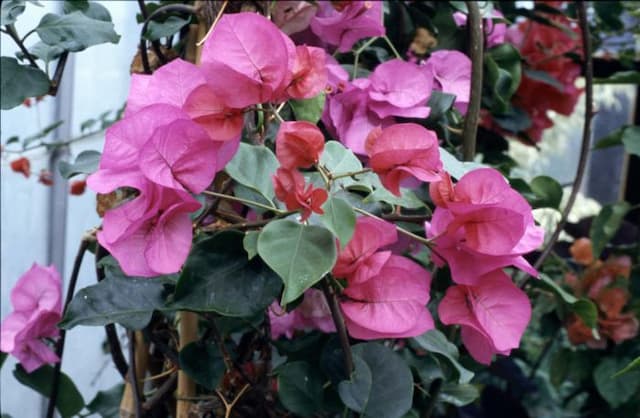



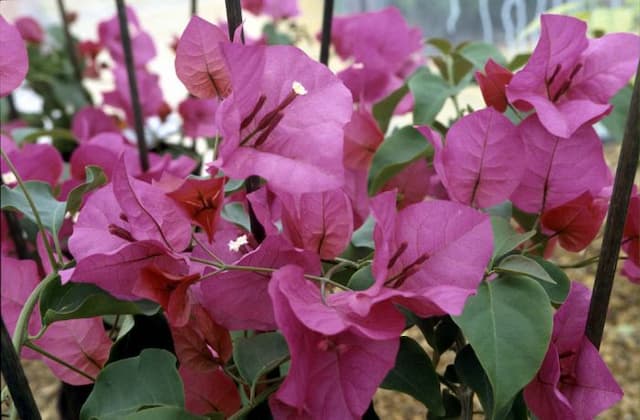
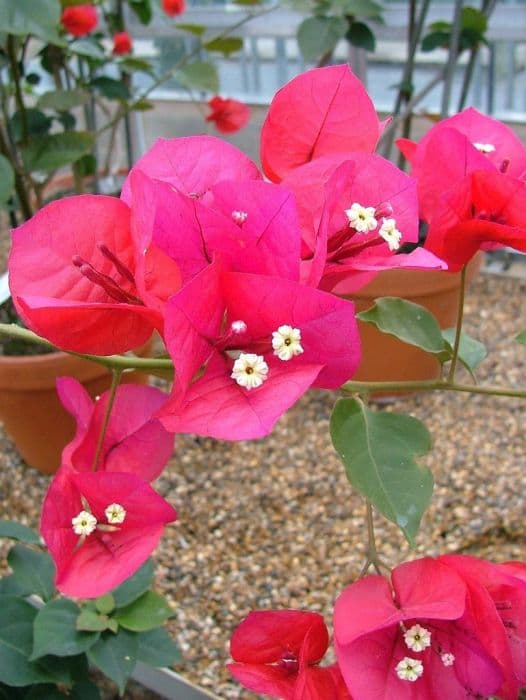
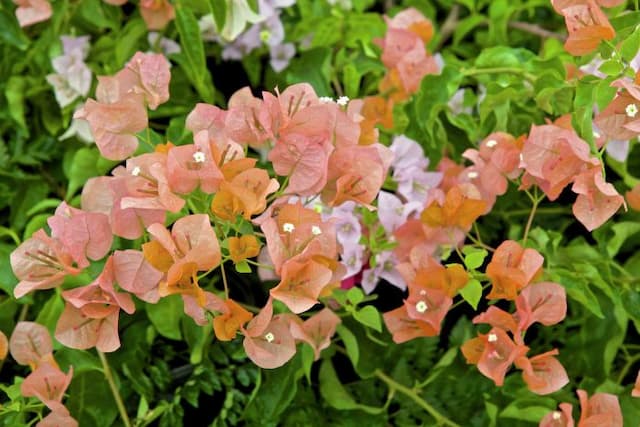
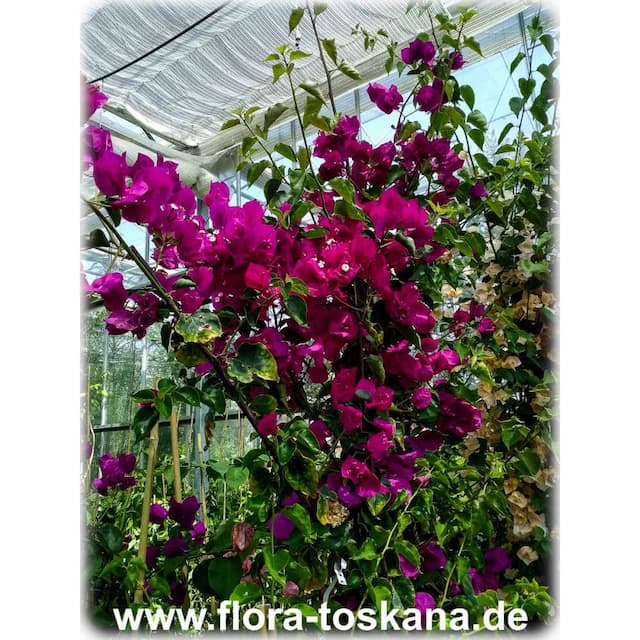
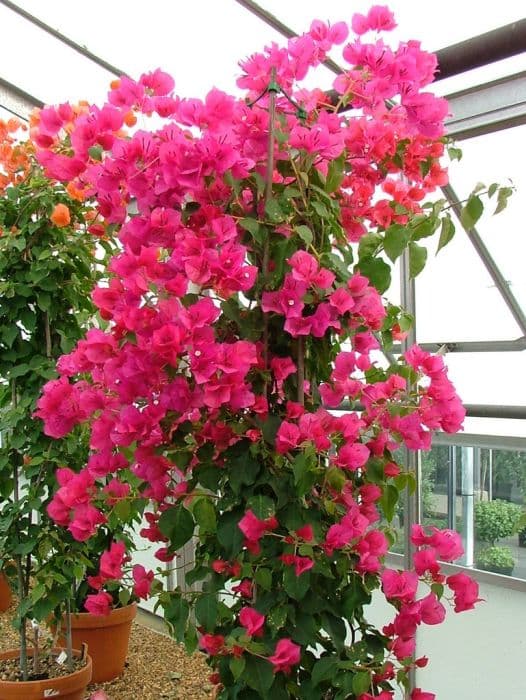
![Bougainvillea [Texas Dawn]](/_next/image?url=https%3A%2F%2Fplants-admin.emdemapps.com%2Fimages%2Fplants%2F%2Fimages%2F604b5f2598081.png&w=640&q=75)